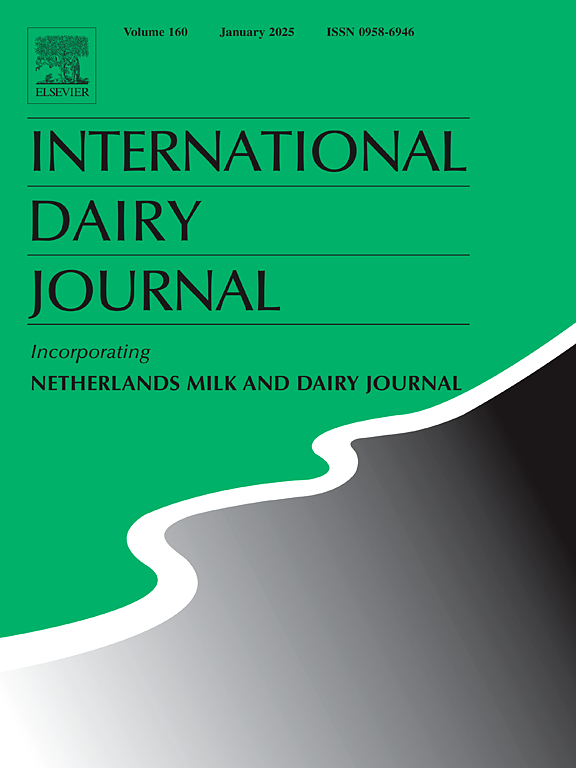抗耐甲氧西林金黄色葡萄球菌的新型噬菌体vB_SauH_SPJ2:表征及其在牛奶安全中的潜在应用
IF 3.4
3区 农林科学
Q2 FOOD SCIENCE & TECHNOLOGY
引用次数: 0
摘要
耐甲氧西林金黄色葡萄球菌(MRSA),耐β-内酰胺类抗生素,提出了关键的治疗挑战。噬菌体(噬菌体)越来越被认为是对抗抗生素耐药病原体的替代疗法。本研究旨在分离和鉴定一种新的靶向MRSA的裂解噬菌体,评估其在破坏生物膜中的效果和作为牛奶生物防治剂的潜力。噬菌体vB_SauH_SPJ2具有潜伏期短(15 min)、爆发量大(99 PFU/细胞)的特点。稳定性测试表明,SPJ2在温度(4-50℃)和pH(3-12)范围内保持稳定。形态学和基因组学分析表明,SPJ2是西尔维亚病毒属的一个新种,属于希尔维亚病毒科的二维病毒亚科,缺乏抗性基因。SPJ2在24 h后显著破坏MRSA SA008(59.05%)、MDR金黄色葡萄球菌SA009(79.15%)和金黄色葡萄球菌CMCC26003(56.72%)预形成的生物膜,抑制生物膜形成的效果分别为86.43%、44.56%和71.38%,呈浓度依赖性。spj2编码的溶酶可以裂解细菌和降解细胞外聚合物(EPS),从而抑制和去除生物膜的合成。在感染多重数(MOI)为1000时,SPJ2在25°C和4°C条件下对金黄色葡萄球菌表现出有效的杀菌活性。值得注意的是,在25°C条件下,SPJ2在6小时内将牛奶中的金黄色葡萄球菌浓度降低到检测不到的水平,显示出卓越的生物防治潜力。采用双因素方差分析(p <;0.05)。这些发现强调了SPJ2对乳制品加工环境的适应性,对MRSA的有效性,以及作为临床和工业应用的增效抗菌药物的前景。本文章由计算机程序翻译,如有差异,请以英文原文为准。
Novel bacteriophage vB_SauH_SPJ2 against methicillin-resistant Staphylococcus aureus: Characterization and potential application in milk safety
Methicillin-resistant Staphylococcus aureus (MRSA), resistant to β-lactam antibiotics, presents critical treatment challenges. Bacteriophages (phages) are increasingly considered an alternative therapy for combating antibiotic-resistant pathogens. This study aimed to isolate and characterize a novel lytic phage targeting MRSA, evaluate its efficacy in biofilm disruption and potential as a biocontrol agent in milk. Phage vB_SauH_SPJ2 was successfully isolated and exhibited a short latent period (15 min) and high burst size (99 PFU/cell). Stability assays showed that SPJ2 remained stable across a broad range of temperatures (4–50 °C) and pH (3–12) conditions. Morphological and genomic analyses revealed that SPJ2 represented a novel species within the Silviavirus genus, belonging to the Twortvirinae subfamily of the Herelleviridae family, lacking resistance genes. SPJ2 significantly disrupted preformed biofilms of MRSA SA008 (59.05 %), MDR S. aureus SA009 (79.15 %), and S. aureus CMCC26003 (56.72 %) after 24 h, while inhibiting biofilm formation by 86.43 %, 44.56 %, and 71.38 % in a concentration-dependent manner, respectively. The SPJ2-encoded lysin may lyse bacteria and degrade extracellular polymeric substances (EPS), thereby inhibiting and removing biofilm synthesis. At a multiplicity of infection (MOI) of 1000, SPJ2 exhibited effective bactericidal activity against S. aureus at 25 °C and 4 °C. Notably, SPJ2 reduced the concentration of S. aureus in milk to undetectable levels within 6 h at 25 °C, demonstrating exceptional biocontrol potential. Statistical significance was analyzed using two-way ANOVA (p < 0.05). These findings highlight the adaptability of SPJ2 to dairy processing environments, efficacy against MRSA, and promise as a synergistic antimicrobial agent for clinical and industrial applications.
求助全文
通过发布文献求助,成功后即可免费获取论文全文。
去求助
来源期刊

International Dairy Journal
工程技术-食品科技
CiteScore
6.50
自引率
9.70%
发文量
200
审稿时长
49 days
期刊介绍:
The International Dairy Journal publishes significant advancements in dairy science and technology in the form of research articles and critical reviews that are of relevance to the broader international dairy community. Within this scope, research on the science and technology of milk and dairy products and the nutritional and health aspects of dairy foods are included; the journal pays particular attention to applied research and its interface with the dairy industry.
The journal''s coverage includes the following, where directly applicable to dairy science and technology:
• Chemistry and physico-chemical properties of milk constituents
• Microbiology, food safety, enzymology, biotechnology
• Processing and engineering
• Emulsion science, food structure, and texture
• Raw material quality and effect on relevant products
• Flavour and off-flavour development
• Technological functionality and applications of dairy ingredients
• Sensory and consumer sciences
• Nutrition and substantiation of human health implications of milk components or dairy products
International Dairy Journal does not publish papers related to milk production, animal health and other aspects of on-farm milk production unless there is a clear relationship to dairy technology, human health or final product quality.
 求助内容:
求助内容: 应助结果提醒方式:
应助结果提醒方式:


